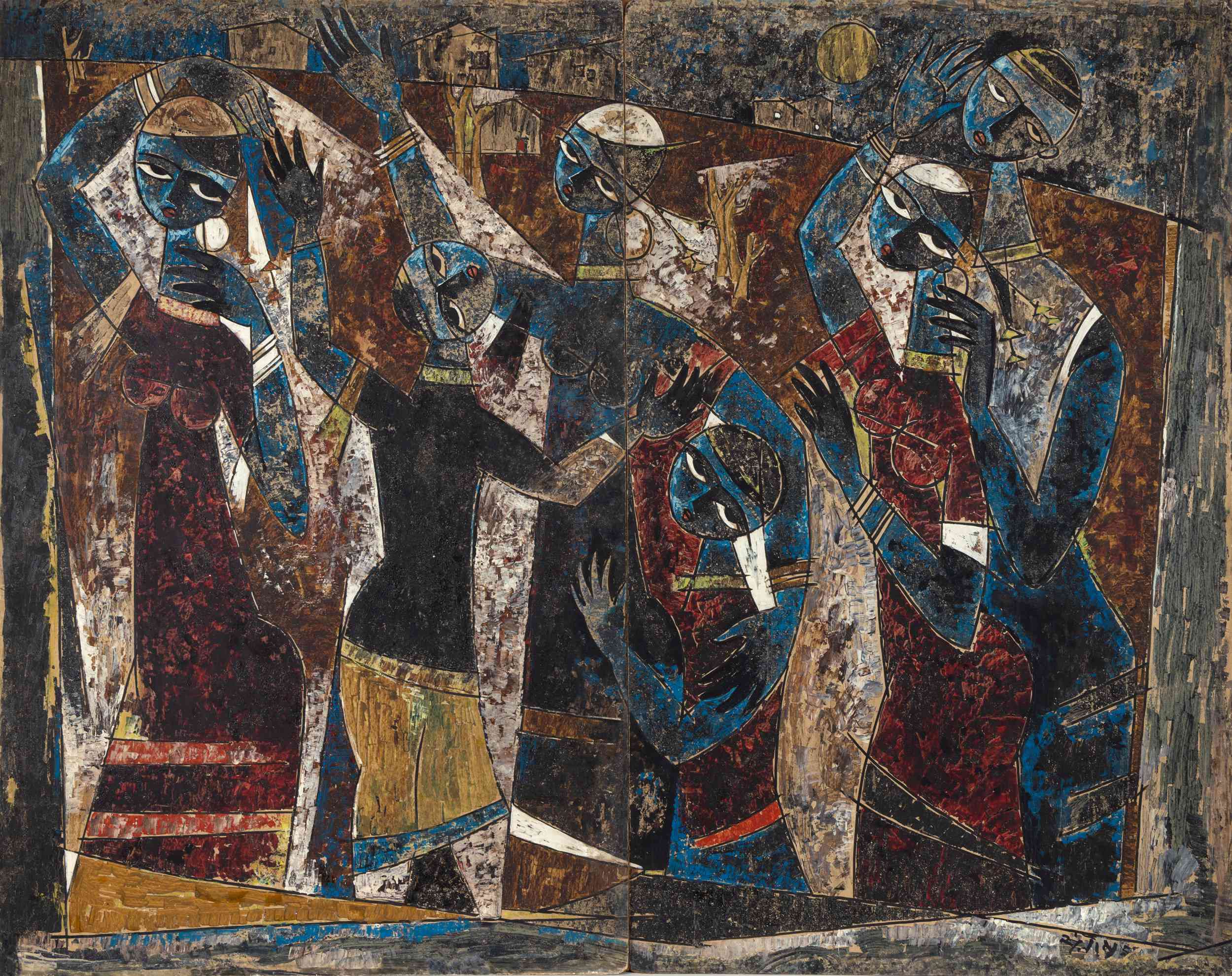Twentieth-century Indian modernism reflects a complex interplay between the legacies of British colonialism, the nationalist movement for Independence, and the evolving realities of a transitional nation. Artistic motives during this period were inherently political, navigating between inherited traditions and the demands of a global, modern aesthetic. At a certain point in history, a key aspect to this evolution was Cubism, a European movement rooted in colonial appropriations, which Indian artists transformed into a tool for asserting creative autonomy and reinterpreting cultural identity. Far from being derivative, Indian modernists fused indigenous philosophies with Cubist principles, blending fragmented forms with cyclical concepts of time and space.
Artists such as Gaganendranath Tagore, GR Santosh, Avinash Chandra, Dhanraj Bhagat, Devayani Krishna and others exemplified this innovative synthesis. This dynamic negotiation extended beyond Cubism, influencing abstract and spiritual practices like the neo-Tantra movement, showcasing how Indian modernism forged a distinctive visual language that balanced global modernist ideas with its cultural heritage. Cubism, as an ideology, is deeply intertwined with the colonialist framework and their biased perceptions of non-Western cultures. When examined through the lens of postcolonial cultural discourse, it emerges as a historically grounded art movement originating in Europe in the early to mid-twentieth century, which exerted far- reaching influences across the world, including on Indian modern art. In India, as elsewhere, experimental artists embraced Cubism to challenge established hierarchies of naturalistic representation and academic sensibilities. At the same time, it inspired Indian modernists to engage with their cultural heritage, exploring the ancient through a new Cubist visual language.

Paris and, post the Second World War, New York, had become the epicentres of artistic modernism and innovation in the twentieth century. Art movements from across the world and, especially, the art produced in still colonised or postcolonial nations was viewed, filtered and assessed through the rubric of art from such Western centres. As a result, any flourishing modernist narrative in the non-Western world was inevitably and unjustly subjected to comparison. Derivation in Western art was largely ignored and viewed as independent intellectual thought, greater than the sum of its sources of inspiration. The same way, for an Indian artist, any deviation from the academic realist style was compared to Western Expressionist and Impressionist art; the fragmentation of form and structure in figurative art was automatically assumed to be Cubist in nature. However, Cubism – like Fauvism, Surrealism, Primitivism and Vorticism, and several other named or unnamed minor Western art movements from the twentieth century – is a movement that is deeply rooted within the colonised land.

Cubism’s early stylistic choices were directly influenced by African artefacts – such as masks and sculptures – that were looted during colonising invasions. These objects were smuggled to Europe and North America, either as private possessions or housed in public institutions as exotic novelties. The reduction of these artefacts to mere curiosities by Western societies stripped them of their complex symbolism that they represented originally – a form of cultural erasure that enabled their artistic appropriation. In many cases, these objects held immense cultural and historical significance for African societies, acting as tools for preserving knowledge, genealogies and historical narratives. In cultures devoid of written record, the loss of these artefacts resulted in the abrupt erasure of local histories. Surveys estimate that almost ninety per cent of African artefacts are still held outside the continent, even though sporadically objects are repatriated – in 2022, Belgium returned the Kakungu mask to the Democratic Republic of Congo; in 2020, the French parliament returned prized objects to Senegal. In recent years, museums and institutions in the UK and Germany have also begun dialogue on decolonising and repatriation. Before Cubist artists of the West drew on mathematics and quantum physics to distort form, they referenced these plundered artefacts to master the broken and angular form.

By the mid-twentieth century, Indian artists were faced with a Sisyphean challenge: they were expected to create art that was distinctly modern and unmistakably Indian, while also competing on a global scale. Comparisons with Western modernism often led to the mischaracterisation of Indian art as derivative or subordinate. However, such challenges provided an opportunity for Indian artists to assert their own identity, developing a new visual language, blending global influence with local tradition. In doing so, they redefined modernism in a postcolonial context, moving beyond Western critique to craft a uniquely Indian narrative. Alongside, they were tasked with reflecting a burgeoning national identity while grappling with the lingering effects of colonial oppression. Most, if not all, artists in this survey were born before India’s Independence, and their work sought to deconstruct colonised identity in the post-1947 landscape. For these modernists, Cubism was rarely the final artistic destination but rather a tool to situate their work within a broader, globally recognised framework. Ultimately, their innovative engagement with Cubist fragmentation fused global and local perspectives, reflecting the evolving nature of Indian modern art.
In India, artistic practices underwent significant changes in the early twentieth century. In 1902, the Japanese artist Okakura Kakuzo (1863-1913) arrived in Calcutta with the monk Oda Tokuno (1860-1911), initiating a cultural exchange that influenced the Bengal School of painting, particularly through the adoption of the Japanese watercolour wash technique. Later, in 1922, artists from the Viennese Bauhaus School showcased their radical experiments in art at the annual exhibition hosted at the Indian Society of Oriental Art in Calcutta, inspiring Indian counterparts like Gaganendranath Tagore (1867-1938) to explore figural fragmentation.
The broken-down picture space evolved from the nationalist protest art of the pre-Independence era to the post-Independence modernisms in Bombay, Delhi and beyond, where artists engaged with Cubism not only as a visual technique but also as means of questioning reality itself. Artists experimenting with fragmented space often unintentionally drew from ancient traditions, which might have otherwise been dismissed as “primitive” by the Western world. This rupture in traditional spatial representation was not simply a stylistic experiment but a subtle reclaiming of heritage – a self-referential nod to the country’s vast and varied past. Tagore’s early work, for example, influenced by the Bauhaus exhibition in Calcutta, reflected an evolving experimentation with geometric fragmentation, blending Cubist or Futurist ideas with Indian miniature painting tradition.

In ancient subcontinental texts, such as the Ramayana and Mahabharata, time is viewed as non-linear, without a specific beginning, end or fixed direction. In some versions of these epics, bards or saints approach the main characters and narrate their life stories to them, creating a self-referential, recursive structure that collapses past, present and future into a single narrative moment. This cyclical perception of time, in which the characters experience their own past and future stories through the eyes of a third-person narrator, aligns with Cubism’s fragmented representation of space and form, which sought to depict multiple perspectives simultaneously. Just as quantum physics in the early twentieth century proposed radical theories about the relativity of time, the potential reversal of its passage and the existence of multiple dimensions, Indian modernists embraced Cubism to challenge conventional artistic representations, blending these scientific insights with their own cultural heritage.
This is an excerpt from an essay from the book Deconstructed Realms – India’s Tryst With Cubism for the eponymous DAG exhibit on display at Windsor Place, New Delhi, until April 5.










